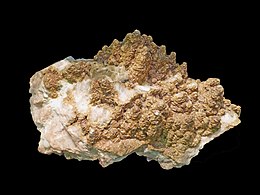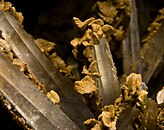Ankerite
| Ankerite | |
|---|---|
 | |
| General | |
| Category | Carbonate mineral |
| Formula (repeating unit) | Ca(Fe,Mg,Mn)(CO3)2 |
| IMA symbol | Ank[1] |
| Strunz classification | 5.AB.10 |
| Crystal system | Trigonal |
| Crystal class | Rhombohedral (3) H-M symbol: (3) |
| Space group | R3 |
| Unit cell | a = 4.8312(2) c = 16.1663(3) [Å]; Z = 3 |
| Identification | |
| Color | Brown, yellow, white |
| Crystal habit | Chrystals rhombohedral with curved faces; columnar, stalactitic, granular, massive |
| Twinning | Simple t {0001}, {1010}. {1120} |
| Cleavage | Perfect on {1011} |
| Fracture | Subconchoidal |
| Tenacity | Brittle |
| Mohs scale hardness | 3.5–4 |
| Luster | Vitreous to pearly |
| Streak | White |
| Diaphaneity | Translucent to transparent |
| Specific gravity | 2.93–3.10 |
| Optical properties | Uniaxial (-) |
| Refractive index | nω = 1.690 - 1.750 nε = 1.510 - 1.548 |
| Birefringence | δ = 0.180 - 0.202 |
| Dispersion | Strong |
| References | [2][3][4] |
Ankerite is a calcium, iron, magnesium, manganese carbonate mineral of the group of rhombohedral carbonates with formula: Ca(Fe,Mg,Mn)(CO3)2. In composition it is closely related to dolomite, but differs from this in having magnesium replaced by varying amounts of iron(II) and manganese. It forms a series with dolomite and kutnohorite.[3]
The crystallographic and physical characters resemble those of dolomite and siderite. The angle between the perfect rhombohedral cleavages is 73° 48', the hardness is 3.5 to 4, and the specific gravity is 2.9 to 3.1. The color is white, grey or reddish to yellowish brown.[5]
Ankerite occurs with siderite in metamorphosed ironstones and sedimentary banded iron formations. It also occurs in carbonatites. In sediments it occurs as authigenic, diagenetic minerals and as a product of hydrothermal deposition.[2] It is one of the minerals of the dolomite-siderite series, to which the terms brown-spar, pearl-spar and bitter-spar have been historically loosely applied.[5]
It was first recognized as a distinct species by W. von Haidinger in 1825, and named for Matthias Joseph Anker (1771–1843) of Styria, an Austrian mineralogist.[3]
It has been found in Western Tasmania, in mines in Dundas, Tasmania.
Image gallery[]

Ankerite on pyrite from King County, Washington

Ankerite on quartz from Peru
See also[]
References[]
- ^ Warr, L.N. (2021). "IMA–CNMNC approved mineral symbols". Mineralogical Magazine. 85: 291–320.
- ^ a b Handbook of Mineralogy
- ^ a b c Ankerite on Mindat.org
- ^ Ankerite on Webmineral
- ^ a b One or more of the preceding sentences incorporates text from a publication now in the public domain: Spencer, Leonard James (1911). "Ankerite". In Chisholm, Hugh (ed.). Encyclopædia Britannica. Vol. 2 (11th ed.). Cambridge University Press. p. 58.
External links[]
| Wikimedia Commons has media related to Ankerite. |
- Calcium minerals
- Magnesium minerals
- Iron(II) minerals
- Manganese(II) minerals
- Carbonate minerals
- Dolomite group
- Trigonal minerals
- Minerals in space group 148
- Luminescent minerals

